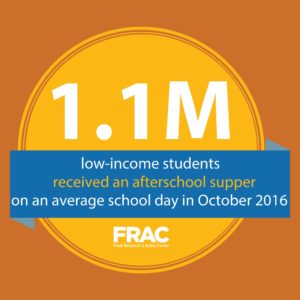Media Contact:
Emily Pickren
epickren@frac.org
202-640-1118
New report highlights the benefits of the Afterschool Nutrition Programs, identifies strategies to reach more low-income children.
 WASHINGTON, March 21, 2018 — Nearly 1.1 million low-income children benefited from afterschool suppers in October 2016, up from just 200,000 children in October 2011, according to the Food Research & Action Center (FRAC). Today, FRAC released Afterschool Suppers: A Snapshot of Participation, it’s first-ever report on participation data in the Afterschool Nutrition Programs, which play a key role in reducing hunger and supporting quality afterschool enrichment programs.
WASHINGTON, March 21, 2018 — Nearly 1.1 million low-income children benefited from afterschool suppers in October 2016, up from just 200,000 children in October 2011, according to the Food Research & Action Center (FRAC). Today, FRAC released Afterschool Suppers: A Snapshot of Participation, it’s first-ever report on participation data in the Afterschool Nutrition Programs, which play a key role in reducing hunger and supporting quality afterschool enrichment programs.
The report includes federally funded afterschool meals participation data nationally and for each state. Because afterschool suppers are a relatively new option that first became available nationwide through the Healthy, Hunger-Free Kids Act of 2010, every state has room to grow participation in the 2017–2018 school year and beyond.
“Afterschool suppers are a game-changer for reducing childhood hunger and drawing children into afterschool enrichment programs,” said Jim Weill, president, Food Research & Action Center. “One of the most effective ways to increase participation in afterschool suppers is to ensure that there are more programs that offer afterschool activities to the children who need them, and that those programs provide suppers.”
While national participation in the Afterschool Supper Program increased at an impressive rate from 2011–2015 — growing by approximately 200,000 children each year — growth slowed significantly in 2016. Only about 48,000 additional children received afterschool suppers in October 2016, compared to the previous October.
Overall, only one child for every 20 low-income children who participated in school lunch in October 2016 received an afterschool supper.
“It’s time to redouble efforts to ensure more low-income children who rely on school lunch also can rely on afterschool supper to stave off hunger,” said Weill.
One barrier is that demand for quality afterschool programming far outstrips the supply in low-income communities, and more public funding is needed to increase the reach of afterschool programs. The largest federal funding source for afterschool educational and enrichment programming, the 21st Century Community Learning Centers program, is on the chopping block in the president’s fiscal year 2019 budget. If funding for this vital program were to be eliminated or reduced, it would have a direct negative domino effect on low-income children’s access to nutritious meals and snacks after school and during the summer.
“We will continue working with our national and state partners to advocate for the 21st Century Community Learning Centers program, and for the afterschool supper connection. Together they provide afterschool programs the resources necessary to ensure children have what they truly need after school: quality programs and nutritious meals,” said Weill.
###
The Food Research & Action Center is the leading national nonprofit organization working to eradicate poverty-related hunger and undernutrition in the United States.


